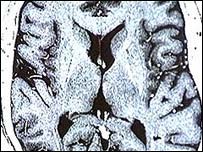Scientists have developed a chemical microchip which could help nerve cells communicate.

|
|
SEE ALSO: Dec 18 2002 Brain's adaptability confounds scientists March 27 - 2002 Scientists boost memory power March 12 - 2003 Scientists develop 'brain chip' March 7 - 2002 Chips to keep family healthy |
|
INTERNET LINKS: New Scientist University of Southampton |
It could work much more like the brain's normal signalling system than existing chips which are stimulated via electricity, say researchers.
The ultimate aim is to create implants which could interact with the body's nervous system.
The chip is an "artificial synapse" which stimulates the junctions where nerve messages travel from one cell to another.
When the process occurs naturally, electrical signals are turned into chemical signals at nerve junctions, or synapses.
A neurotransmitter released from one synapse is picked up by molecular receptors on another, triggering a new electrical impulse.
Neurotransmitters affect each cell differently, and the same neurotransmitter affects different cells in different ways.
For example, the neurotransmitter used by retinal cells turns some cells on and others off.
Sensitive responses
The synapse chip developers hope it could replace existing devices such as cochlear implants which stimulate nerve cells directly - and indiscriminately - with electrical impulses.
Researchers from Stanford University in California believe their synapse chip could act more like the brain's natural processes than the electrically-charged chip because it could allow for very sensitive and specific responses.
They have been able to create four artificial synapses on a silicon chip one centimetre square.
Each synapse is a tiny hole in the silicon, which is just 5,000 nanometres wide - a nanometre is a millionth of a millimetre.
Even though this is much bigger than a real synapse, it can stimulate just one cell in a layer above the chip.
This happens when an electrical field is applied, a neurotransmitter stored in a special "pipeline" in the chip is pumped out to stimulate nearby cells.
'Telegraph to mobile phones'
|
" There are huge obstacles to be overcome" Dr John Chad, University of Southampton |
Mark Peterman, one of the scientists who is developing the artificial synapse, estimates that 1,000 artificial synapses firing 1,000 times a second would need as little as half a millilitre of fluid to function for 250 years.
Gerald Loeb, from the University of Southern California told New Scientist magazine that powerful devices could be produced by combining chemical and electrical stimulation in one implant.
However, the researchers accept several hurdles remain to be overcome such as stopping the device becoming clogged with immune cells and replenishing the reservoir.
Dr John Chad, a senior lecturer in the School of Biological Sciences at the University of Southampton, told BBC News Online: "There are huge obstacles to be overcome in producing a reliable interface to the brain with useful information throughput, some of them mentioned in the article.
"However, the success of techniques such as cochlear implants shows that the brain can utilise relatively sparse information to good effect, and this device could turn out to be an early fore-runner of complex computer-brain interfaces."
He added: "An analogy would be the relationship of the early telegraph systems to the latest mobile phones."